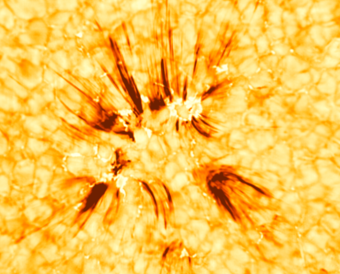The chromosphere, a 2000 kilometer thick layer of plasma with temperatures of a few thousand degrees, is located between the Sun‘s visible surface and its hot outer atmosphere. During solar eclipses, this layer is visible as a thin red ring around the occulted solar disc. Elongated, finger-like plasma flows, so-called spicules, are omnipresent in this layer. These short-lived structures are created by interactions in the Sun‘s complex magnetic field, as a group of scientists including the Max Planck Institute for Solar System Research (MPS) in Germany now reports in the journal Science. In addition, the spicules supply the outer solar atmosphere, the corona, with energy and thus contribute to its gigantic temperatures of several million degrees. For their observations, the research group used data from the Big Bear Solar Observatory in the USA, the largest ground-based solar telescope, and NASA‘s space probe Solar Dynamics Observatory.
The Sun's outer atmosphere, the so-called corona, is incredibly hot: at several million degrees, its temperatures are many times higher than those of the underlying chromosphere - even though the corona is much further away from the Sun's heat-generating core. How the energy required to heat the corona to such high temperatures is transported there, is one of the great unanswered questions in solar physics. Various attempts to explain this hold, among other things, shock waves, magnetohydrodynamic processes or various magnetic phenomena responsible.
In addition, solar researchers have suspected the long, finger-like spicules in the chromosphere to play a role. The team led by Dr. Tanmoy Samanta from Peking University has now been able to substantiate this suspicion. "Through targeted observations from the ground and from space, we were able to show that the spicules contribute to heating the corona," says MPS scientist Prof. Dr. Hardi Peter, who contributed substantially to the new study, summing up the results.
Spicules are as common as they are mysterious. The enormous structures, typically 5000 kilometres long, occur everywhere in the chromosphere, sometimes in clusters. Within the spicules, plasma flows at average speeds of between 15 and 40 kilometres per second. However, as they are only about 200 kilometres wide, it is almost impossible to observe them with smaller solar telescopes. "Spicules have a very slender shape," Peter describes his research object. "Their ratio of length to width is comparable to that of giant sequoias.“
The Goode Solar Telescope at Big Bear Solar Observatory in California, part of the New Jersey Institute of Technology, offered ideal conditions for the new study. With a main mirror diameter of 1.6 meters, it is currently the largest and most powerful solar telescope in the world. For the first time, the researchers were able to use an instrument new to the observatory for their research: the Near Infrared Imaging Spectropolarimeter, an instrument that examines infrared radiation from the Sun and thus determines the properties of solar magnetic fields. In addition, optimal observing conditions prevailed during the measuring campaign: uninterrupted visibility for about ten minutes - an important prerequisite for following the spicules‘ evolution in time. The "Sun‘s fingers" typically have lifetimes of one to twelve minutes.
The new study shows that groups of spicules in particular occur in regions with a similar architecture of the magnetic field. In principle, a dynamically changing network of areas with positive magnetic polarity covers the solar surface. Scientists interpret this pattern as an expression of enormous up- and downflows from deeper layers. However, the exact physical processes are still unclear. According to the new data, the finger-like plasma flows occur, where the network of strong magnetic fields of positive polarity is accompanied by a weaker field of negative polarity. "The magnetic fields in these areas seem to reorganize in such a way that energy is released thus generating spicules," concludes Peter.
A look at the transition region between the chromosphere and the corona with the help of NASA‘s space probe Solar Dynamics Observatory allowed for further conclusions. The data revealed that the spicules channel hot plasma and thus energy into the corona. "Whether the spicules provide enough energy to explain the total temperature difference between the chromosphere and the corona is still unclear," says Peter. "However, our results show, that the spicules must certainly be a part of any overall theory of coronal heating."
Contact
Dr. Birgit Krummheuer
Press and Public Relations
+49 551 384979-462
Krummheuer@...
Prof. Dr. Hardi Peter
+49 5556 979-413
peter@...


